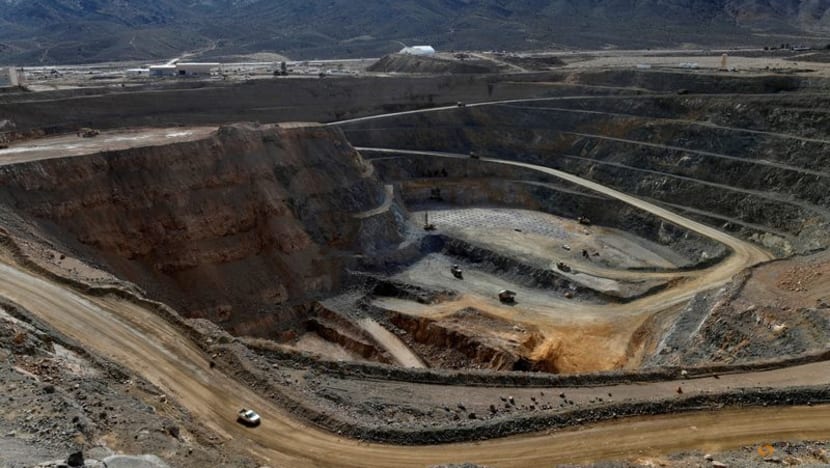Commentary: Critical minerals are a US headache, not an emergency
History tells us engineers and entrepreneurs will deliver the US from the current hysteria, says Javier Blas for Bloomberg Opinion.

LONDON: In the 1950s, the US was worried about the supply of mercury, because the liquid metal was key to power walkie-talkies during the Korean War.
In the 1980s, analysts warned that mineral shortages to rival the Organization of the Petroleum Exporting Countries (OPEC) oil shock could undermine the Cold War arsenal. Today, the concern is about China cornering the market for lithium and cobalt, which are needed for high-capacity batteries.
The panic over the years has inevitably influenced policy even if heeding cooler heads would offer reassurance. Which brings us to the current US administration.
Donald Trump cloaks his imperial ambitions for Ukraine and Greenland with the desire to exploit their rare earths. Only this month, the White House announced several executive orders on critical minerals. Read what Trump signed, and it feels like USA Inc is experiencing a supply crunch depriving it of key ingredients to make electric cars, fighter jets and supercomputers.
MARKET FORCES CAN BE COUNTED ON
The reality is very different. Market forces, rather than government intervention, can be counted on to resolve any shortages. First, because the costs involved are tiny – sums that Elon Musk’s Department of Government Efficiency eats for lunch. The worst warnings centre around minerals with an annual import bill measured in a few dozen million dollars, not billions.
Second, because US companies have demonstrated time and time again that they are able to reengineer their products to suit mineral supplies; third, because the US still has plenty of allies (or at least trade partners) willing to supply the commodities. Only a handful of minerals are truly dominated by China, and none of them is truly critical.
By critical, I mean that a shortfall would prove disastrous for the economy and undermine national security. But that’s not what critical means in the current context.
Sure, a few industries will suffer some annoyance – and higher prices – if the supply of, say, cobalt, molybdenum, rare earth elements or lithium was disrupted. Would anyone else notice? Not at all. In most cases, glitches will be short-lived.
HEADACHE MINERALS
So let’s rebrand the conundrum – let’s talk about headache minerals rather than critical minerals. The problem? That doesn’t sound nearly as sexy.
Obviously, if one is in the business of getting read and building a brand, as think tanks and lobbyists are, the very worst possible headline for a pamphlet, research paper – or, God forbid, opinion column – is one that concludes “all is largely fine”. One could instead write “please, don’t read this” and go home.
But that doesn’t attract eyeballs. Instead, today’s influencers will focus on worst-case scenarios: supply chain Armageddon.
When will the shortage of critical minerals hit? “Soon.” How bad would it be? “Severe” sounds about right, but best to say “destructive”. What and who will be affected? Point to everything and everyone, but if you really want to be read in the White House – and that’s a must – say “national security”. What’s the mineral at issue? Pick the most obscure element from the periodic table, and call it “critical”, “strategic”, or, even better, “rare”.
The Heritage Foundation, a Washington think tank close to the Trump administration, produced a paper in December 2024 warning about potential shortages of critical minerals undermining the defence industry. Ironically, the paper sounds very much like the similar one the think tank published in 1981, also warning about shortages.
Another Washington think tank, the Center for Strategic and International Studies, published its own report, flagging a “national security imperative” in critical minerals such as lithium iron phosphate.
We simply don’t know what American engineers will invent next. But we can safely assume they will try to replace whatever is in short-supply and expensive.
HIGH PRICES CAN CURE HIGH PRICES
Having read multiple reports about critical minerals spanning nearly 75 years, I can spot a few more patterns, one in particular: the Cassandras tend to bet against American engineering. Time and time again, they assume that US companies won’t innovate their way out of a mineral headache.
However, that’s exactly what engineers did every time. Take batteries: The chemistry has constantly changed, from mercury in the 1950s to an overreliance on cobalt in the early 2000s to new formulas today using other metals.
Remarkable, too, is how little faith the doubters have in the profit motive. High prices cure high prices. If the economic incentive is there, miners will scour the planet for new sources, rebalancing the market over time. Look at cobalt and lithium: The high prices of a few years ago have led to a glut.
The main problem with many critical minerals is that they are too cheap, and therefore few can compete against China and the handful of other producing nations. Let prices increase, and supply will come.
Let’s hope cooler heads prevail, letting the invisible hand of the market cure the headache; because the critical minerals issue is just that – a headache.

















